Pet
Labradoodle Puppies Brisbane: What to Know Before You Apply
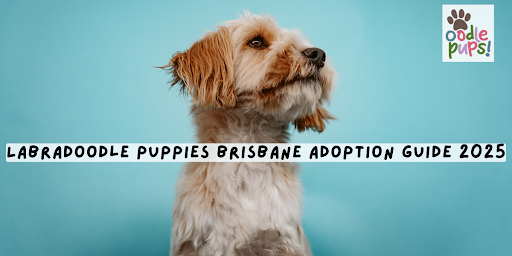
Before you adopt a Labradoodle puppy, you need to know the right questions to ask, what health checks to look for, and the application steps.
We know you’re excited about bringing home that adorable, fluffy bundle of joy. But if you don’t prepare properly, you could choose the wrong breeder or worse, miss out on your dream puppy altogether.
That’s why we at oodle pups help Brisbane families pick the right puppy through our honest breeding practices and helpful advice.
Here’s what we’ll share with you in this article:
- How to choose the right Labradoodle type
- What makes a breeder trustworthy and ethical
- The adoption process from application to puppy pickup
- Open adoption benefits and ongoing breeder support
- Training essentials for your puppy’s first days home
Keep reading to learn about the adoption process of Labradoodle puppies in Brisbane.
Labradoodle Puppies in Brisbane: How to Choose the Right Match
When choosing the perfect family puppy, you should consider your lifestyle, living space, and what coat type works best for your home.
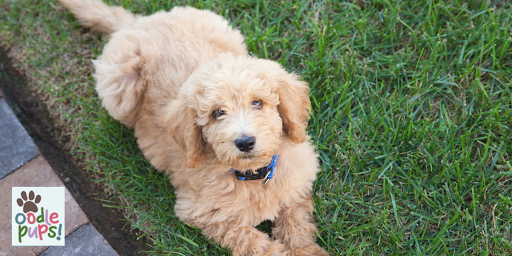
Though Brisbane families have amazing options when searching for Labradoodle puppies, not every puppy suits every household. The reason is simple: different generations of this breed offer varying coat types and energy levels. Once you understand these differences, you can find the puppy that fits your family perfectly.
If allergies are a concern in your home, multi-generational Labradoodles typically offer the most predictable coats. These puppies come from parents who are both Labradoodles, which gives you better odds of that sought-after fleece or wool coat.
So for minimal shedding and allergy-friendly options, you’ll want to focus on F1B or multigenerational choices rather than first-generation crosses.
Another important factor worth considering is age. If you have kids at home, slightly older puppies (around 10-12 weeks) are often a better choice, as they’ve had extra time for socialisation.
After all, you don’t want a clueless puppy teaming up with your equally clueless toddler.
Once you know what type of Labradoodle suits your lifestyle, the next step is finding a breeder who can match you with your ideal puppy. Next, we’ll cover how to find reputable breeders who can deliver on their promises.
Finding Reputable Breeders for Prospective Adoptive Parents
Finding reputable breeders for Labradoodle puppies in Brisbane requires knowing what separates ethical businesses from puppy mills or backyard breeders.
Here’s how to identify the genuine breeders who care about their dogs’ well-being:
What to Look For in an Ethical Breeder
You should look for comprehensive health testing documentation, transparent communication policies, and detailed information about both birth parents to identify an ethical breeder.
What sets good breeders apart is how readily they provide extensive details about their adoption process and encourage multiple contact opportunities before you commit. The reason they do this is that ethical breeders view themselves as guardians of the breed rather than simply sellers of puppies.
So you get someone who genuinely cares whether your new pup becomes a couch potato or an adventure buddy, not just someone counting their profit margins.
Useful Tip: Ask to see health testing certificates for canine hip dysplasia, elbow clearances, and eye examinations for both parent dogs. This way, you can spot any breeder who gets shifty about paperwork or makes excuses about “lost documents.”
Now that you understand what makes a breeder trustworthy, let’s walk through what you can expect during the adoption process itself.
The Labradoodle Adoption Process Explained
Wondering what happens between falling in love with those fluffy photos and bringing your new mate home? Don’t worry. We’ve got you covered.
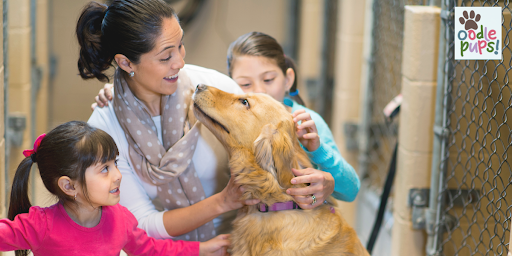
In this section, we’re going to discuss the typical steps most Brisbane breeders follow, from your initial application through to pickup day. Though the process might seem long, there’s a good reason behind each step.
The Application and Waiting List
Your adoption process begins with filling out an application that covers everything from your living situation to your experience with dogs.
What happens next is that most reputable breeders want to meet potential families either in person or through video calls before adding you to their waiting list. They do this step to ensure their puppies go to homes where they’ll receive proper care and attention.
In our experience, families who complete thorough applications and show genuine interest in the breed typically move through the process more smoothly. All you have to do is be honest about your expectations and lifestyle, and the right breeder will work with you to find the perfect match.
Puppy Selection Process
After a litter is born, responsible breeders will provide regular information updates, including photos, videos, and growth progress as the puppies grow. You can even request specific updates about puppies that catch your eye early on.
The next step is when most breeders start the selection process when puppies are 6-8 weeks old. This timing allows families time to observe personalities and make informed choices based on actual behaviour.
In this period, you’ll see which pups are the adventurous explorers and which ones prefer quiet cuddles. And if you request a calm family companion, your breeder may suggest a puppy who shows more relaxed behaviour during their daily assessments and play sessions.
Helpful Tip: Choose based on temperament and energy level that match your daily routine rather than falling for the first adorable face you see.
However, remember that puppies are still developing their personalities, so even the most careful selection can lead to some unpredictable surprises once they settle into your home.
Open Adoption and Preparing for Puppy Life
Once you’ve selected your perfect puppy match, the journey toward bringing them home involves understanding what open adoption means and how to prepare for their arrival.
Rather than a quick handoff, the transition from breeder to your family should be smooth and supportive. This approach benefits both you and your new companion by ensuring ongoing guidance when you need it most.
Let’s break down what open adoption offers and how to prepare your home for your new arrival.
What is Open Adoption and Its Benefits
An open adoption process means your breeder maintains ongoing contact and support throughout your puppy’s life, creating a safety net for both you and your new family member.
Even experienced dog owners benefit from having access to detailed guidance about training, health concerns, and breed-specific questions that come up over time.
When breeders offer open adoption, they provide contact details for ongoing support and remain available for questions about your puppy’s development. This creates a strong foundation of trust and ensures you always have expert advice when challenges arise.
The result is a safer, more confident experience for new owners and better outcomes for the puppies. It’s a win-win situation where everyone benefits from the ongoing relationship.
Essential Training and Care After Adoption
What’s the first thing you should focus on when your puppy arrives home? Well, the answer is establishing routines and boundaries from the very first moment they step through your door.
Your new family member will learn best when you:
- Start house training immediately with consistent schedules.
- Begin basic commands using positive reward methods.
- Create a safe space for their rest and comfort.
We suggest you find an experienced local vet who understands Labradoodles and can monitor your puppy’s health and well-being throughout their development. The more your vet knows about the breed’s specific needs and potential health concerns, the better they can guide you.
When you establish these foundations early, you’re setting up both yourself and your new companion for years of happiness together.
Your Path to the Perfect Labradoodle Companion
Many people feel overwhelmed by the choices and decisions involved before choosing their ideal Labradoodle puppy in Brisbane.
But with proper research and the right breeder partnership, you can avoid common mistakes and find a healthy, well-socialised companion who fits your family perfectly.
We’ve walked you through choosing the right generation and coat type, identifying reputable breeders, understanding the adoption process, and preparing for your puppy’s arrival. Each step builds toward one goal: ensuring you and your new family member start your journey together with confidence and support.
If you need to learn more about Labradoodle adoption in Brisbane, our experienced team is here to guide you through every step of this exciting journey.
Pet
Why Pets Often Become Anchors During Major Life Changes
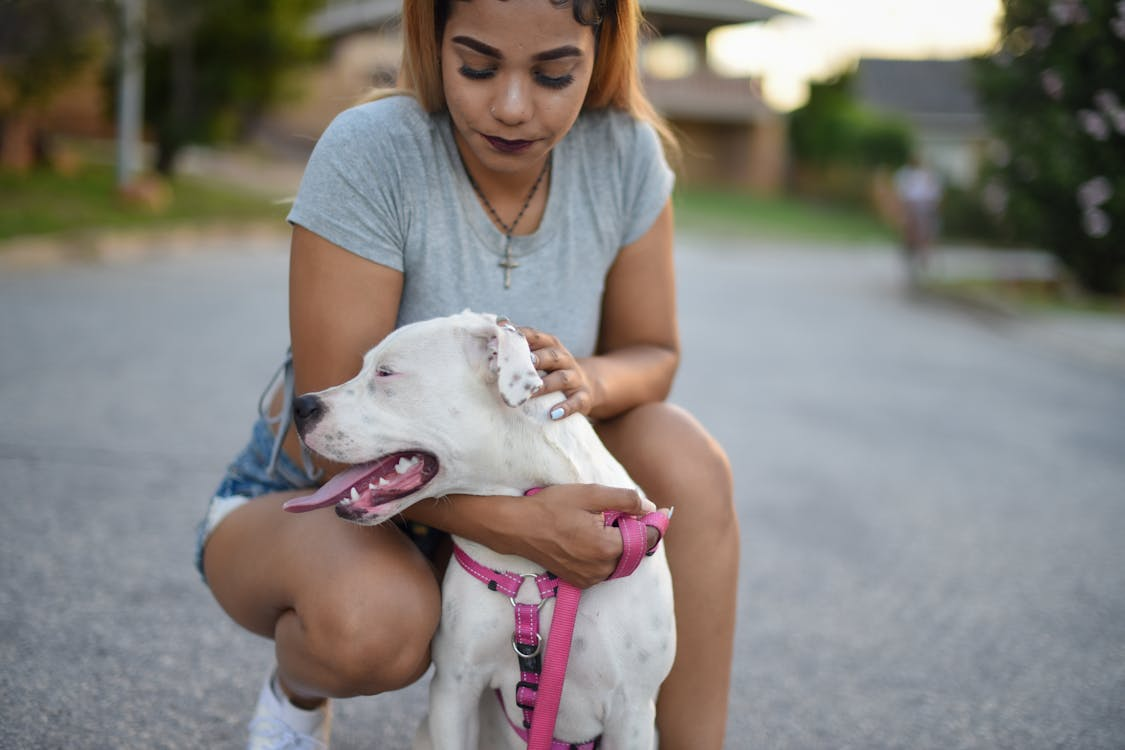
Life is full of transitions, for example, moving into a new city, starting over in a different job, adjusting to health challenges, or adapting to family changes. Such changes can shake the structure of daily life, leaving people searching for grounding. Pets, in their quiet and steady way, often step into that role. They provide comfort, familiarity, and stability when the rest of life feels unsettled.
In Colorado, where people juggle fast-moving urban spaces and the calm of mountain communities, the role of pets during transitions becomes even clearer. Whether it’s a dog waiting at the door, a cat curling up during a late night of unpacking, or a smaller companion that thrives on routine, animals remind their owners of continuity. Their companionship connects people to steady patterns and emotions that anchor them through change.
Easing Loneliness
Relocating to a new city or stepping into a major life change can create long stretches of loneliness. Without friends or familiar support systems, the silence of a new space can weigh heavily. Pets help close that gap. Their presence fills the quiet with warmth, turning isolation into something gentler. A wagging tail or steady purr becomes a reminder that companionship is always close.
For those who want to make this relationship more secure, resources like Colorado Emotional Support Animal registration help ensure pets can remain with their owners in housing or travel scenarios. Knowing that an animal’s companionship is protected offers peace of mind. In those early days of transition, this assurance makes the difference between feeling alone and feeling supported.
Unconditional Affection
Major life changes often bring uncertainty about relationships, work, or identity. Amid such shifts, pets provide affection that doesn’t change with circumstances. Their loyalty remains the same no matter what is happening outside. Coming home to a dog that greets you with excitement or a cat that curls into your lap can be grounding in a way that words rarely match.
This type of affection creates a safe emotional space. People who are adjusting to change know they can count on their pets to respond with warmth. That predictability helps them feel secure and strengthens resilience. In times when everything feels uncertain, unconditional love from a pet becomes an anchor.
Responsibility
During disruptive times, days can lose their shape. Regular tasks like work, meals, or rest may feel disorganized or scattered. Caring for a pet provides structure when life doesn’t. Feeding schedules, daily walks, grooming routines, and vet visits require attention and consistency, giving owners reliable touchpoints in their day.
The act of meeting a pet’s needs restores a sense of purpose. Even when someone feels uncertain about their own direction, the responsibility of caring for another living being keeps them moving forward. In this way, responsibility transforms from a duty into a steadying force that helps people cope with transition.
Outdoor Activity
Pets, especially dogs, naturally guide owners into outdoor activity. A morning walk, an evening trip to the park, or a weekend hike becomes part of life when a dog is involved. Such outings provide more than exercise; they bring routine, fresh air, and opportunities to reset during overwhelming periods.
Outdoor activity also creates connections. Walks through a neighborhood may lead to conversations with neighbors, while time on local trails fosters interaction with other pet owners.
Comfort in Loss
Loss, whether of a loved one, a relationship, or a familiar way of life, creates some of the most painful transitions people face. During grief, pets provide comfort in ways that are subtle but profound. They don’t ask questions or expect explanations; they simply stay close, offering warmth and presence.
That companionship matters deeply. For someone navigating grief, a pet may be the reason they get out of bed, prepare a meal, or step outside for air. The routines tied to caring for the animal bring forward momentum in small but meaningful ways.
Resilience Support
Stressful changes test resilience, often leaving people feeling drained. Pets help renew emotional strength by offering calm, consistency, and small joys that soften the weight of difficult times. Their steady presence introduces balance into days that might otherwise feel chaotic.
Stroking a pet’s fur, sharing playtime, or sitting quietly together provide breaks from overwhelming thoughts. Such moments of calm accumulate, slowly building resilience.
Helping Children
When families go through transitions, children often feel the effects most strongly. A new home, a separation, or the arrival of a sibling can bring confusion and insecurity. Pets give children a sense of consistency through these changes. Caring for or simply being around a pet helps children find stability when other parts of their lives feel uncertain.
Kids who struggle to express their feelings may find comfort in talking to or spending quiet time with their animal. This sense of trust allows children to process transitions at their own pace, supported by the reliability of a pet’s companionship.
Nonjudgmental Companions
Major changes often bring self-doubt or worry about how others perceive us. Pets offer companionship free from judgment. They don’t weigh decisions or critique choices, but simply remain present and loyal.
This acceptance creates a safe emotional space. During times when people feel vulnerable, knowing they have a pet that loves them unconditionally helps restore confidence.
Sense of Home
Relocation is one of the most disruptive changes people experience. Packing up, adjusting to a new environment, and settling into unfamiliar surroundings can make life feel unsteady. Pets help bridge that gap by carrying familiar routines into new places. Their presence creates continuity, turning an unfamiliar house or apartment into a place that feels like home.
Feeding a pet at the same time, walking a familiar route, or hearing the sound of a pet moving through the house brings a sense of comfort.
Silent Witnesses
Pets often act as quiet observers through the highs and lows of life. They see both struggles and successes without judgment or commentary. This role of silent witness provides a unique kind of support, one built on presence rather than words.
During major changes, this steady companionship becomes invaluable. Owners know they have someone by their side, even if that someone cannot speak. Pets bear witness to life’s most difficult and most rewarding moments, offering continuity that anchors their owners through it all.
Life’s changes are inevitable, but the presence of pets transforms how those changes are experienced. From easing loneliness and providing comfort in grief to supporting resilience and creating a sense of home, pets serve as anchors during times of uncertainty. Their loyalty, routines, and affection give people something steady to hold onto when everything else feels unsettled.
Pet
Why the Right Crate Makes All the Difference in Dog Training Success
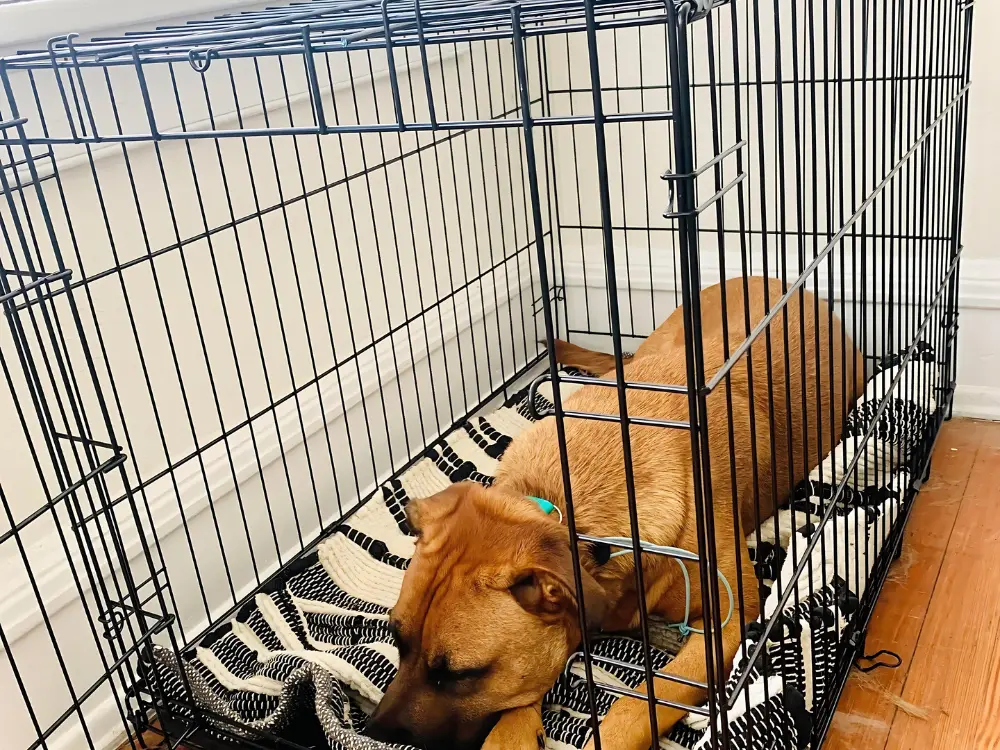
Training a dog isn’t just about commands and treats — it’s about setting the right environment. One of the most overlooked, yet impactful tools in any dog training journey is the crate. Whether you’re working with a rambunctious puppy, a newly adopted rescue, or a stubborn adolescent, having a consistent, calming, and secure space can change everything. That’s why Impact Crates offer the ideal training setup for modern dog owners who want structure without stress.
Crates have evolved far beyond basic containment. Today’s high-quality crates are designed with behavioral psychology, dog safety, and everyday functionality in mind. And when integrated properly into a training routine, a crate doesn’t restrict — it empowers.
Let’s explore how and why the right crate can turn chaos into confidence during training.
Crates as a Foundation, Not a Shortcut
One common misconception among new dog owners is that a crate is simply a place to “put the dog” when things get tough. But that kind of thinking can actually undermine training progress. A well-used crate isn’t a punishment — it’s a place of consistency, boundaries, and security.
Dogs are den animals by nature. When introduced gradually and positively, crates provide a private zone that promotes calm behavior. Trainers often use crates during:
- Potty training to teach control and routine
- Impulse control exercises like “settle” or “stay”
- Time-outs not as punishment, but as a break from overstimulation
- Travel or public outings to reinforce structured behavior
When these moments are supported by a crate that feels safe and comfortable, dogs learn faster and trust more deeply.
Design Matters: Why Not All Crates Are Equal
The structure and build of the crate itself have a huge influence on how well it functions in training. Wobbly, noisy, or hard-to-clean crates can disrupt progress, especially for dogs who are easily startled or anxious.
That’s why serious trainers and behaviorists gravitate toward durable, thoughtfully engineered models — ones that support the training environment rather than work against it.
Crates like those from Impact Dog Crates are designed specifically for this purpose. They provide stability, airflow, and security in a package that feels solid and grounded. Their build reduces the distractions that come from rattling wire panels or collapsible plastic. And for dogs with high reactivity or anxiety, this kind of containment can create a true sense of calm.
Structure Builds Confidence
One of the biggest benefits of crate training is how it fosters independence and emotional regulation. When dogs know they have a consistent place to go, they start developing the ability to self-soothe. This is especially helpful in multi-dog households, homes with kids, or busy environments where dogs can feel overstimulated.
Crates become a base — a home within a home — where the dog can rest, decompress, and reset. For nervous dogs or those who are learning boundaries for the first time, this structure builds confidence. They start to feel in control of their space and choices, which reduces behavioral issues like barking, chewing, or guarding.
How Crates Support Every Training Stage
Training doesn’t stop once your dog learns “sit” or “stay.” Behavior shaping is a lifelong process, and a crate can be a reliable tool through every stage:
Puppies:
Crates help manage energy, enforce potty routines, and protect them from getting into trouble when unsupervised.
Adolescents:
During the teenage phase, dogs test boundaries. Crates reinforce expectations while offering breaks during overwhelming moments.
Adults:
For dogs with reactivity, leash frustration, or separation issues, crate time offers rest and clarity between training sessions.
Seniors:
Older dogs benefit from a quiet, predictable space — especially when they begin to feel more sensitive to noise or change.
With the right setup, your dog’s crate evolves with them — not as a crutch, but as a companion to their emotional growth.
What Real Dog Owners Are Saying
People who’ve integrated crates into their training plans often report faster progress and fewer setbacks. Testimonials from experienced dog handlers reveal common themes:
- “My dog settles much faster after a training session when she goes into her crate.”
- “Using the crate between lessons keeps my reactive dog from getting overstimulated.”
- “Once I made the crate a positive place, potty training clicked almost overnight.”
It’s not about locking your dog away — it’s about giving them a place to process, reset, and rest. Just like humans benefit from quiet time after learning something new, dogs need space to internalize behaviors.
Avoiding Common Mistakes
Even with the best intentions, crate training can go wrong if owners rush the process or create negative associations. To avoid setbacks:
- Never use the crate as punishment.
- Always reward calm behavior in and around the crate.
- Introduce the crate gradually with short sessions, especially with puppies or rescues.
- Keep the crate near family activity, so the dog doesn’t feel isolated.
- Use training guides to help develop a routine that supports your specific goals.
Many owners have found helpful tips and structured routines from training-focused resources that emphasize crate integration as a core principle of dog development.
Pet
Incorporating Horse Jumps into Your Training Routine

Incorporating horse jumps into equestrian training routines not only adds excitement but also serves as a crucial element for developing both horse and rider skills. Jumping is more than just an exhilarating part of equestrian sport—it forms the foundation for building confidence, improving coordination, enhancing athletic ability, and deepening the bond between rider and horse. Whether you are training for competitive events or simply seeking to enrich your riding prowess, integrating jumps into your routine offers a dynamic pathway to achieving those goals.
Benefits of Horse Jumps
Horse jumps are integral in training routines due to their multifaceted benefits. First, jumps challenge the horse physically, enhancing cardiovascular endurance, muscle strength, and flexibility. This improves the horse’s athletic capabilities and aids in preventing injuries by keeping the muscles and joints well-conditioned. Additionally, jumping exercises sharpen the horse’s mental acuity by encouraging focus and responsiveness. This cognitive stimulation improves a horse’s problem-solving abilities and adaptability during competitions.
Jumps are instrumental in developing core strength, balance, and posture for riders. Navigating a horse over various obstacles requires physical and mental synchronicity, cultivating greater unity and understanding between the rider and horse. Moreover, jumping provides an engaging way to practice steering, pacing, and precision, enhancing overall riding skills and confidence. These accumulated skills dramatically improve performance, regardless of whether the rider is a novice or a seasoned competitor.
Types of Jumps and Their Roles
Incorporating various types of horse jumps into your routine can offer targeted benefits and cater to different training objectives. Here we look at some common types:
Vertical Jumps: These consist of poles or planks placed at a single height, requiring the horse to clear them in a vertical trajectory. They are excellent for enhancing jumping technique and sharpening accuracy. Vertical jumps demand precise timing and coordination, making them an invaluable fundamental component of any training routine.
Oxers: Also known as spread fences, oxers comprise two or more vertical elements with space between them. They encourage horses to lengthen their jumping stride, improving their power and flexibility. Integrating oxers into training routines can teach horses about distance judgment, a critical skill during competitive jumping events.
Cross Rails: These poles intersect, forming an “X” shape, and typically serve beginners or warm-up exercises. Cross rails effectively develop initial jumping skills and build confidence in inexperienced horses and riders alike.
Combination Jumps: Combination jumps consist of a series of jumps set in close succession. They demand quick adjustments from both horse and rider, improving agility and decision-making speed. Using combination jumps in training helps simulate competitive conditions, providing a comprehensive test of timing and coordination.
Integrating Jumps into Training Routines
Introducing horse jumps into a training routine involves strategic planning to maximize their impact. Begin assessing the horse and rider’s skill level, selecting appropriate jumps to gradually build their abilities without overwhelming them. Start with lower, simpler jumps and increase the difficulty as proficiency improves, always aligning the complexity of training with the rider and horse’s comfort and preparedness levels.
Structured training sessions should incorporate a blend of different jumps to address various skill areas while maintaining engagement. Diverse exercises prevent monotony and encourage continuous development, ensuring both horse and rider are equipped to handle a variety of scenarios. For instance, sessions might start with cross rails to warm up, progress to vertical jumps for precision drills, and finish with oxers to practice expansive leaps.
Regular feedback and reflection after training runs are pivotal for improvement. Riders should assess which elements were challenging and adjust future sessions to focus on refining those skills. Documenting sessions can also help track progress and ensure that routines evolve alongside gains in the horse and rider’s confidence and capabilities.
Safety Practices for Jump Training
Ensuring a safe environment is paramount when incorporating jumps into equestrian training. Safety begins with appropriate gear for both rider and horse. Protective headgear, such as helmets, should be non-negotiable for the rider, while well-fitted boots and gloves can offer additional grip and stability. For horses, protective boots shield their legs from impact, and a properly fitted saddle enhances comfort, ensuring free movement.
Jumps should always be constructed of suitable materials and checked for stability before each session. Breakaway features are essential, allowing components to detach safely upon impact, reducing the risk of injury. Additionally, choosing the correct surface is crucial—a flat, non-slip arena is ideal for providing the necessary traction.
Overseeing sessions with the guidance of an experienced trainer or instructor can preemptively identify safety risks and provide immediate feedback. They can assist in adjusting techniques and ensuring that both horse and rider maintain correct positions throughout their training. An expert eye can markedly enhance skill development while prioritizing safety.
Conclusion
Incorporating horse jumps into your training routine can catalyze a transformative journey for both horse and rider. The multifaceted benefits of jumps, from physical conditioning to mental acuity, significantly elevate equestrian skills and deepen the partnership between rider and horse. Through thoughtful planning, diverse jump types, and a focus on safety, jump training can be seamlessly integrated into your routine, encouraging continual growth and enjoyment. Whether preparing for the rigors of competition or enhancing personal riding experiences, jumps offer a robust, engaging means to enrich your equestrian journey.

 Blog10 months ago
Blog10 months agoHow to Deal with Scabies While Traveling

 Travel10 months ago
Travel10 months agoRichmond, Virginia Street Art Guide

 Travel10 months ago
Travel10 months agoPerhentian Islands: How to Get There, What to Expect, & More

 Travel10 months ago
Travel10 months agoHow to Live in Your Car in New Zealand

 Travel10 months ago
Travel10 months agoSouvenir in Nepal: A Guide to Unique Handicrafts and Cultural Treasures

 Travel10 months ago
Travel10 months agoVegan Guide to Dining Out in Richmond, Virginia

 Food10 months ago
Food10 months agoVegetarian Food Nepal: A Journey into Flavorful Plant-Based Cuisine

 Travel7 months ago
Travel7 months agoA Local’s Guide to Sanibel Island, Florida















